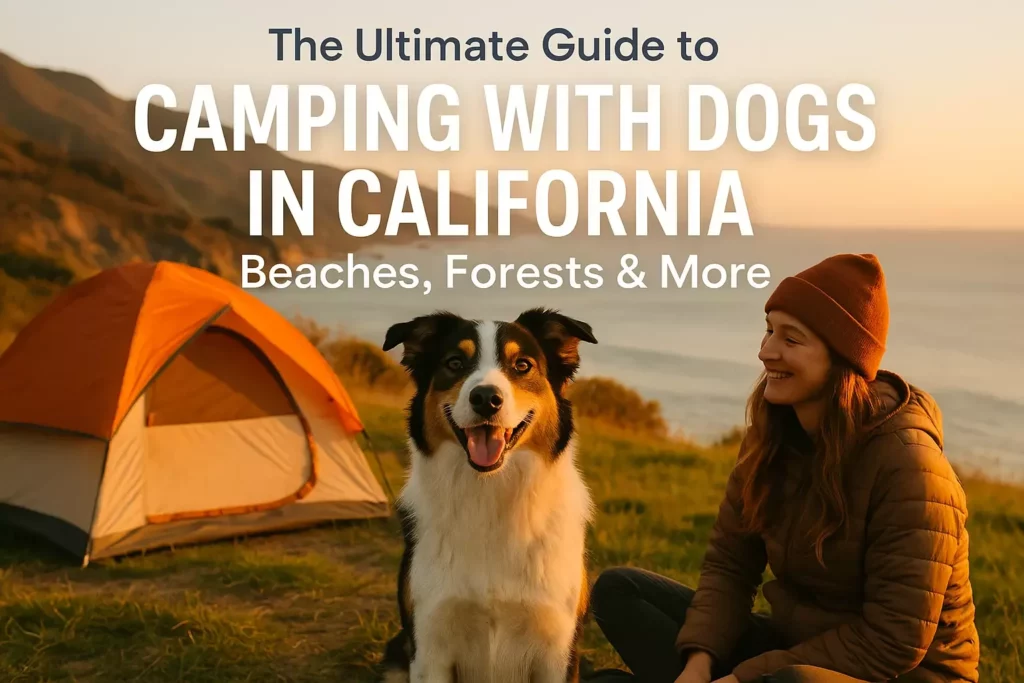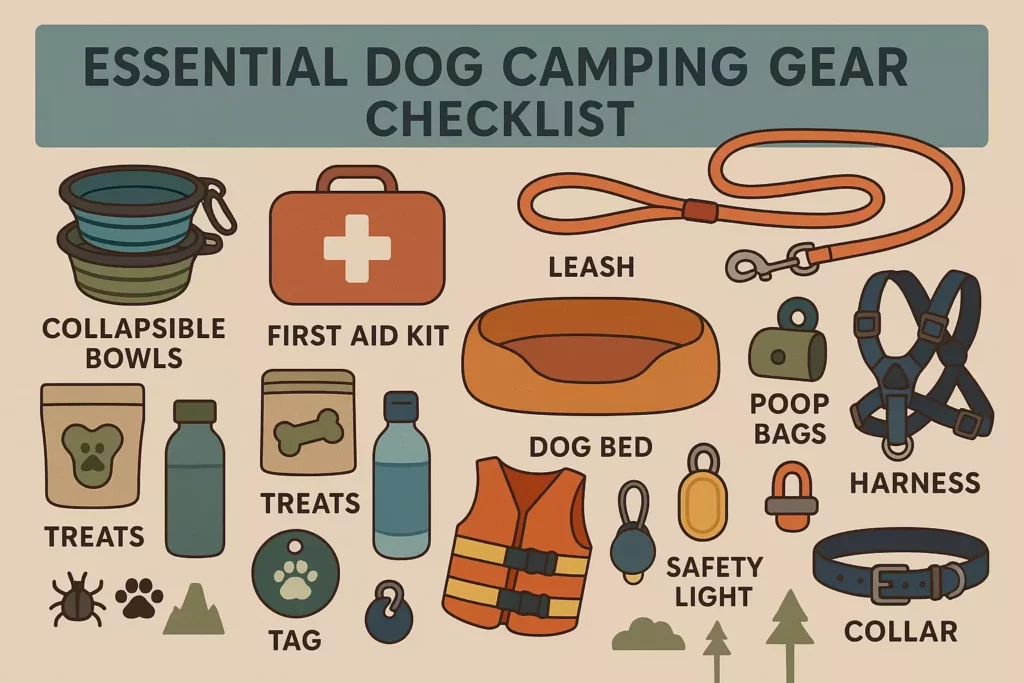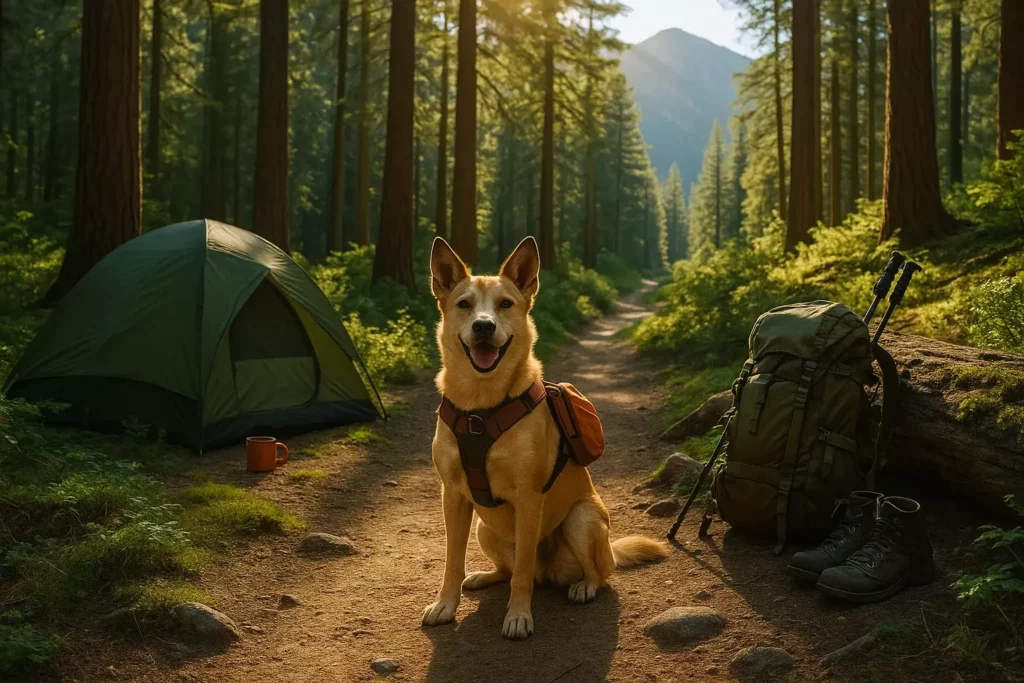The Ultimate Guide to Camping with Dogs in California: Beaches, Forests & More
Picture this: your furry best friend racing across golden sand dunes at sunrise, tail wagging as ocean waves crash nearby, while you sip coffee from your camping mug. California offers some of the most spectacular dog-friendly camping experiences in the world, from coastal adventures to mountain retreats. Whether you’re planning your first camping trip with your canine companion or you’re a seasoned outdoor enthusiast looking for new destinations, this comprehensive guide will help you discover the best camping with dogs in California while ensuring both you and your pet have an unforgettable adventure.

Key Takeaways
- California offers diverse dog-friendly camping options including beaches, forests, deserts, and mountains with varying pet policies and amenities
- Proper preparation is essential – pack a comprehensive pet kit, research campground rules, and ensure your dog’s vaccinations and identification are current
- Beach camping requires special considerations like saltwater safety, sand protection, and tide awareness for your dog’s wellbeing
- Forest and mountain camping presents unique challenges including wildlife encounters, temperature changes, and terrain considerations
- Following Leave No Trace principles and campground etiquette ensures continued access to dog-friendly outdoor spaces for all pet owners
Why California is Perfect for Camping with Dogs
California’s diverse landscape makes it an ideal destination for camping with dogs. The Golden State boasts over 280 state parks, numerous national forests, and countless private campgrounds that welcome four-legged visitors. From the rugged coastline of Big Sur to the towering redwoods of Northern California, pet owners have access to an incredible variety of outdoor experiences.
The state’s year-round camping season means you can plan adventures in any season, though timing is crucial for your dog’s comfort and safety. California’s pet-friendly culture extends to its outdoor recreation areas, with many campgrounds offering specialized amenities for pets including dog runs, waste stations, and even pet washing areas.
Essential Preparation: Pets Tips for California Camping
Pre-Trip Health and Safety Checklist
Before embarking on your California camping adventure, ensure your dog is ready for the outdoors. Schedule a veterinary checkup within 30 days of your trip to confirm vaccinations are current, especially rabies, DHPP, and Bordetella. California’s diverse ecosystems expose dogs to various health risks, making preventive care essential.
Required Documentation:
- Current vaccination records
- Health certificate (if traveling from out of state)
- Microchip information and registration
- Emergency veterinary contact information
- Pet insurance details (if applicable)
Packing the Perfect Pet Kit
Creating a comprehensive pet kit ensures you’re prepared for any situation. Start with the basics and add items specific to your planned activities and destinations.
Essential Pet Camping Gear:
- Food and Water: Pack 1.5 times your normal amount, plus collapsible bowls
- First Aid Supplies: Include gauze, antiseptic wipes, tweezers, and emergency medications
- Comfort Items: Familiar bedding, favorite toys, and calming aids
- Safety Equipment: LED collar lights, reflective vest, and sturdy leash
- Weather Protection: Dog booties, cooling vest, and rain gear
For more comprehensive packing strategies, check out our guide on how to pack your backpack for camping and learn about building your first aid kit for both human and pet emergencies.
Best Beach Camping with Dogs in California
Top Coastal Destinations
California’s coastline offers numerous dog-friendly camping opportunities, each with unique characteristics and regulations. Here are the premier destinations for beach camping with your canine companion:
🏖️ Pismo Beach State Park
Located on the Central Coast, Pismo Beach allows dogs on leash throughout the campground and on designated beach areas. The wide, sandy beaches provide excellent exercise opportunities, while the mild climate makes it comfortable year-round.
🌊 Doheny State Beach
In Orange County, Doheny offers both tent and RV camping with direct beach access. Dogs are welcome on leash, and the protected bay area provides calmer waters ideal for dogs new to ocean swimming.
🦭 San Onofre State Beach
This San Diego County gem features bluff-top camping with stunning ocean views. The beach allows leashed dogs, and the nearby trails provide additional exercise options when beach conditions aren’t ideal.
Beach Safety Tips for Dogs
Beach environments present unique challenges for dogs. Saltwater exposure can cause dehydration and stomach upset if consumed in large quantities. Always provide fresh water and rinse your dog after beach activities to remove salt and sand from their coat and paws.
Critical Beach Safety Measures:
- Monitor for signs of saltwater poisoning (vomiting, diarrhea, lethargy)
- Protect paws from hot sand with booties or by walking during cooler hours
- Watch for dangerous marine life and sharp objects
- Understand tide schedules and rip current warnings
- Provide shade during peak sun hours
Forest and Mountain Camping Adventures

Premier Forest Destinations
California’s forests offer cooler temperatures and diverse terrain perfect for active dogs. These destinations provide excellent hiking opportunities and stunning natural beauty.
🌲 Los Padres National Forest
Spanning the Central Coast ranges, Los Padres offers numerous dog-friendly campgrounds with access to hundreds of miles of trails. The varied elevation provides options for different fitness levels and seasonal preferences.
🏔️ Tahoe National Forest
Surrounding the iconic Lake Tahoe, this forest provides alpine camping experiences with crystal-clear lakes and mountain vistas. Many campgrounds offer direct lake access for swimming and water activities.
🌿 Mendocino National Forest
Less crowded than coastal alternatives, Mendocino offers peaceful camping among oak woodlands and coniferous forests. The moderate elevation and numerous creeks provide comfortable conditions for dogs.
Wildlife Awareness and Safety
Forest camping requires heightened awareness of wildlife interactions. California’s forests are home to bears, mountain lions, coyotes, and other wildlife that may pose risks to pets.
Wildlife Safety Protocol:
- Store all pet food in bear-proof containers
- Keep dogs on leash and close to camp, especially at dawn and dusk
- Make noise while hiking to avoid surprising wildlife
- Never allow dogs to chase or approach wild animals
- Report wildlife sightings to campground staff
For wilderness preparedness, consider reviewing our bushcraft survival kit guide to enhance your outdoor safety knowledge.
Desert and Inland Camping Options
Unique Desert Experiences
California’s desert regions offer distinctive camping experiences with dramatic landscapes and clear night skies. However, desert camping with dogs requires careful planning due to extreme temperatures and unique hazards.
🌵 Joshua Tree National Park
While dogs aren’t allowed on trails within the park, nearby BLM lands and private campgrounds provide desert camping opportunities with stunning Joshua Tree views. The unique landscape offers excellent photography opportunities and stargazing.
🏜️ Anza-Borrego Desert State Park
California’s largest state park allows dogs on leash in campgrounds and on designated trails. The spring wildflower blooms create spectacular scenery, though summer temperatures can be dangerous for pets.
Desert Safety Considerations
Desert environments pose significant risks to dogs, particularly heat-related illnesses and paw injuries from hot surfaces and sharp desert plants.
Desert Camping Essentials:
- Plan activities for early morning and evening hours
- Test ground temperature with your hand before allowing dogs to walk
- Carry extra water (1 gallon per dog per day minimum)
- Inspect paws regularly for cuts, thorns, and burns
- Provide constant shade and cooling options
Campground Etiquette and Regulations
Understanding Pet Policies
Each campground has specific pet policies that must be followed to ensure continued access for all pet owners. Common regulations include leash requirements, quiet hours, and waste disposal rules.
Universal Pet Camping Rules:
- Dogs must remain on leash (typically 6-foot maximum)
- Owners must clean up all pet waste immediately
- Pets cannot be left unattended at campsites
- Aggressive or disruptive animals may be asked to leave
- Maximum number of pets per campsite (usually 2-3)
Being a Responsible Pet Camper
Responsible pet ownership in campgrounds ensures positive experiences for all visitors and maintains access to outdoor spaces for future trips.
Best Practices for Pet Campers:
- Research campground policies before arrival
- Book pet-friendly sites in advance (often limited availability)
- Bring documentation of vaccinations and licenses
- Maintain control of your dog at all times
- Respect wildlife and other campers’ space
- Follow Leave No Trace principles
Seasonal Considerations and Weather Planning
Spring Camping (March-May)
Spring offers mild temperatures and wildflower blooms, making it ideal for camping with dogs. However, be prepared for variable weather and muddy conditions from winter rains.
Spring Preparation Tips:
- Pack layers for temperature fluctuations
- Bring waterproof gear for unexpected rain
- Check trail conditions before hiking
- Be aware of increased wildlife activity
- Consider tick prevention measures
Summer Camping (June-August)
Summer provides the longest days and warmest weather but requires careful heat management for dogs. Coastal areas remain comfortable, while inland and desert locations can be dangerous.
Summer Safety Priorities:
- Plan activities for early morning and evening
- Provide constant access to shade and water
- Consider cool weather clothes for high-elevation destinations
- Monitor for signs of heat exhaustion
- Choose coastal or high-elevation campgrounds
Fall and Winter Camping
Fall offers comfortable temperatures and fewer crowds, while winter camping requires specialized gear and planning. Some high-elevation campgrounds close during winter months.
🏕️ California Dog-Friendly Campground Finder
Find the perfect camping destination for you and your furry friend
Health and Emergency Preparedness
Common Camping Health Issues for Dogs
Outdoor adventures expose dogs to various health risks that indoor pets rarely encounter. Being prepared for common issues can prevent minor problems from becoming serious emergencies.
Frequent Camping Health Concerns:
- Cuts and scrapes from rough terrain or sharp objects
- Dehydration from increased activity and heat exposure
- Gastrointestinal upset from drinking untreated water or eating unfamiliar items
- Insect bites and stings from bees, wasps, or spiders
- Plant poisoning from toxic vegetation like poison oak or mushrooms
Building a Comprehensive Pet First Aid Kit
A well-stocked first aid kit can address most minor injuries and stabilize serious conditions until veterinary care is available. Customize your kit based on your destination and planned activities.
Essential First Aid Supplies:
- Gauze pads and self-adhesive bandages
- Antiseptic wipes and antibiotic ointment
- Digital thermometer (normal dog temperature: 101-102.5°F)
- Tweezers for splinter and tick removal
- Emergency medications prescribed by your veterinarian
- Contact information for emergency veterinary clinics
For comprehensive first aid preparation, review our detailed guide on building your first aid kit to ensure you’re prepared for both human and pet emergencies.
Emergency Action Plan
Develop a clear emergency action plan before departing for your camping trip. Know the location of the nearest emergency veterinary clinic and have multiple communication methods available.
Emergency Preparedness Steps:
- Research emergency veterinary clinics near your campground
- Download offline maps and emergency contact information
- Ensure cell phone is fully charged with portable backup power
- Inform campground staff of your pet’s presence and any special needs
- Establish check-in times with family or friends
Water Safety and Hydration
Safe Water Sources for Dogs
Access to clean, safe drinking water is crucial for your dog’s health during camping trips. Natural water sources may contain harmful bacteria, parasites, or chemicals that can cause serious illness.
Water Safety Guidelines:
- Always pack sufficient fresh water for the entire trip
- Treat natural water sources before allowing dogs to drink
- Monitor dogs around fast-moving water or strong currents
- Prevent drinking from stagnant pools or streams with algae blooms
- Rinse dogs after swimming in saltwater or chlorinated pools
Learn about effective water purification methods to ensure safe drinking water for both you and your pet during extended camping trips.
Recognizing Dehydration in Dogs
Dogs can become dehydrated quickly during outdoor activities, especially in warm weather or at high altitudes. Early recognition and treatment prevent serious complications.
Signs of Dehydration:
- Excessive panting or drooling
- Loss of skin elasticity (skin doesn’t snap back when gently pulled)
- Dry or sticky gums
- Lethargy or weakness
- Loss of appetite
Sleeping Arrangements and Comfort
Tent Camping with Dogs
Sharing tent space with dogs requires planning to ensure everyone stays comfortable and warm throughout the night. Consider your dog’s size, sleeping habits, and temperature needs when planning arrangements.
Tent Setup Tips:
- Choose a tent with adequate space for all occupants
- Bring familiar bedding to help dogs feel secure
- Position dog bedding away from tent walls to prevent condensation
- Consider a separate sleeping pad for insulation from cold ground
- Pack extra blankets for temperature regulation
For guidance on selecting appropriate gear, check out our recommendations for choosing the right sleeping bag and tent setup strategies.
RV and Cabin Camping Options
RV and cabin camping provide more comfortable accommodations for dogs, especially during extreme weather conditions. Many pet-friendly RV parks and cabin rentals offer specialized amenities for traveling pets.
RV/Cabin Advantages:
- Climate-controlled environment
- Secure indoor space for anxious dogs
- Kitchen facilities for preparing pet meals
- Bathroom access for emergency situations
- Storage space for pet supplies and equipment
Activities and Entertainment for Camping Dogs

Exercise and Mental Stimulation
Camping provides excellent opportunities for physical exercise and mental stimulation that indoor environments can’t match. Plan activities appropriate for your dog’s fitness level and interests.
Engaging Camping Activities:
- Trail hiking on designated dog-friendly paths
- Beach running and swimming in safe areas
- Scent games using natural environments
- Fetch and frisbee in open spaces
- Agility challenges using natural obstacles
Rainy Day Activities
Weather doesn’t always cooperate with camping plans. Having backup activities keeps dogs entertained and exercised during inclement weather.
Indoor/Covered Activities:
- Training sessions and trick practice
- Interactive puzzle toys and treat dispensers
- Gentle stretching and massage
- Quiet bonding time and grooming
- Mental stimulation games using camping supplies
For families camping with children and dogs, explore our family camping activities guide for ideas that engage both kids and pets.
Meal Planning and Nutrition
Maintaining Regular Feeding Schedules
Consistent meal times help dogs feel secure and maintain digestive health during camping trips. Plan meals carefully to ensure adequate nutrition while managing food storage and preparation challenges.
Feeding Best Practices:
- Maintain regular meal times as much as possible
- Pack 25% extra food in case of extended stays
- Use airtight containers to prevent spoilage and wildlife attraction
- Bring familiar food to avoid digestive upset
- Monitor appetite changes that may indicate stress or illness
Camping Meal Ideas for Dogs
While maintaining your dog’s regular diet is ideal, camping presents opportunities for special treats and easy meal preparations that work well in outdoor settings.
Simple Camping Dog Meals:
- Pre-portioned kibble in daily containers
- Freeze-dried meals that require only water
- Homemade trail mix with dog-safe ingredients
- Fresh fruits and vegetables as healthy snacks
- Frozen treats for hot weather cooling
For inspiration on outdoor cooking techniques, review our campfire cooking guide for ideas that can be adapted for pet meal preparation.
Leave No Trace with Pets
Environmental Responsibility
Practicing Leave No Trace principles while camping with dogs ensures that natural areas remain pristine for future visitors and wildlife. Pet owners have additional responsibilities beyond standard camping ethics.
Leave No Trace for Pet Owners:
- Pack out all pet waste in designated bags
- Keep dogs on designated trails to prevent erosion
- Don’t allow dogs to chase or disturb wildlife
- Use established campsites rather than creating new ones
- Respect vegetation by preventing dogs from digging or trampling
Waste Management Strategies
Proper waste disposal is crucial for environmental protection and public health. Plan waste management strategies before arriving at your campsite.
Effective Waste Management:
- Bring biodegradable waste bags for remote areas
- Double-bag waste for extended backpacking trips
- Research campground disposal facilities and policies
- Never bury pet waste in natural areas
- Consider portable waste disposal systems for extended trips
Building Positive Camping Memories
Photography and Documentation
Camping trips with dogs create lasting memories worth preserving. Plan photography sessions that capture both the stunning landscapes and special moments with your pet.
Photography Tips:
- Photograph during golden hour for best lighting
- Capture action shots during activities
- Include landscape backgrounds to show scale and beauty
- Take candid shots of quiet moments
- Create a camping journal with photos and notes
Progressive Training for Future Adventures
Each camping trip provides opportunities to build your dog’s outdoor skills and confidence. Progressive training prepares dogs for more challenging adventures over time.
Skill Building Progression:
- Start with short, easy trips close to home
- Gradually increase trip length and complexity
- Introduce new environments and challenges slowly
- Reward positive behaviors and calm responses
- Build confidence through successful experiences
For families new to camping, our camping with kids guide offers strategies that work well when introducing both children and pets to outdoor adventures.
Conclusion
California offers unparalleled opportunities for camping with dogs, from pristine beaches to majestic forests and unique desert landscapes. Success in pet-friendly camping comes from thorough preparation, respect for regulations, and prioritizing your dog’s safety and comfort throughout the adventure.
The best camping with dogs in California experiences result from matching destinations to your pet’s abilities and interests while following essential pets tips for outdoor safety. Whether you choose coastal adventures at Pismo Beach, forest explorations in Los Padres, or desert discoveries near Joshua Tree, proper planning ensures memorable experiences for both you and your furry companion.
Start planning your next California camping adventure by researching pet-friendly campgrounds, assembling comprehensive gear lists, and building your dog’s outdoor skills through progressive training. The Golden State’s diverse landscapes await you and your four-legged adventure partner.
Take Action Today:
- Research and book pet-friendly campgrounds for your preferred dates
- Schedule a pre-trip veterinary checkup for your dog
- Begin assembling your comprehensive pet camping kit
- Start training exercises to build your dog’s outdoor confidence
- Connect with other pet camping enthusiasts for tips and recommendations






